Tiny, modular Linux system targets embedded apps
Jun 13, 2007 — by LinuxDevices Staff — from the LinuxDevices Archive — 5 views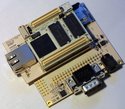 Canadian single-board computer (SBC) startup Virtual Cogs has started shipping its first product: a miniature, modular, embeddable, Linux-based computer. The VC21 is comprised of a Freescale i.MX21-powered processor module, along with a dozen stackable, “Cog”-branded daughterboards that add cameras,… touchscreens, sound cards, and so on.
Canadian single-board computer (SBC) startup Virtual Cogs has started shipping its first product: a miniature, modular, embeddable, Linux-based computer. The VC21 is comprised of a Freescale i.MX21-powered processor module, along with a dozen stackable, “Cog”-branded daughterboards that add cameras,… touchscreens, sound cards, and so on.
The core of the VC21 system is the VCMX212 processor module, which measures 2 x 1.75 inches (50 x 44 mm) — about half the size of a business-card. It is powered by a Freescale i.MX21, an SoC (system-on-chip) that targets mobile devices such as cordless VoIP phones and portable media players.
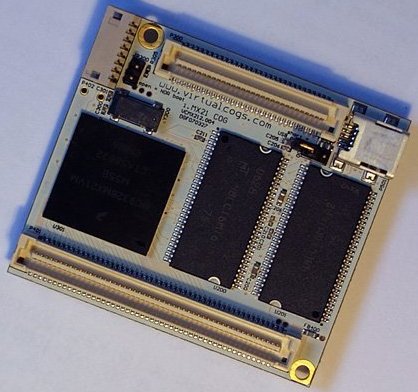
VCMX212 processor module
The VCMX212 module's Freescale i.MX21 processor integrates a 266MHz ARM926EJ-S core, along with LCD and keypad controllers, video acceleration core, a camera interface, memory and storage interfaces, and various standard PC I/O interfaces.

Freescale i.MX21 function block diagram
(Click to enlarge)
The VCMX212 processor module combines the i.MX21 SoC with 64MB of 133MHz DRAM, 16MB of NOR flash (where the bootloader and Linux OS reside), and a DC/DC converter that accepts 3.3-5.5 Volts. An onboard Silabs asynchronous serial-to-USB converter bridges the processor's first UART to a development host PC, where output from the bootloader and OS consoles can be directed. A jumper can be set to enable the host PC to power the module via the USB connection.
Additionally, the VCMX212 has a “mini-JTAG” connector, where an available board can be attached to provide a normal IDC-20 JTAG connector.

Available IDC-20 JTAG board
(Click to enlarge)
“Cog” daughterboards
The VCMX212 processor module connects to daughterboards via two pass-through surface-mount connectors mounted top and bottom. The first connector exposes the i.MX21's 16-bit memory bus, while the second exposes the SoC's peripheral signals.
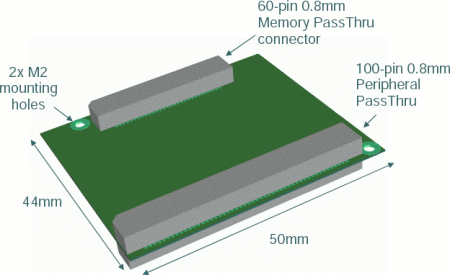
VC21 board configuration
The VCMX212's pass-through connectors allow a variety of off-the-shelf or custom Cog daughterboards to be attached, either above or below the processor board. Inter-board spacing can range from 0.2 inches (5 mm) to 0.6 inches (16mm), depending on the board-to-board connector chosen.
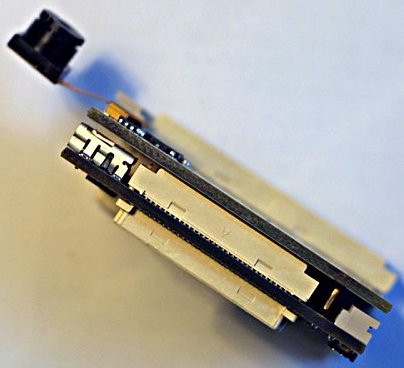
VCMX212 and a Cog daughtercard
Available off-the-shelf Cog daughterboards, as listed by Virtual Cogs, include:
- Breakout cog — breaks out GPIO signals on the pass-through connectors. Also contains an RS-232 converter, SD-card and a DC/DC converter with 5-20V input
- Ethernet Cog — 10/100BASE-T interface
- Camera Cog — SVGA CMOS camera interface
- Multimedia Cog — Touchscreen 320×240 3.5-inch TFT LCD interface and audio codec
- Robot Cog — ARM7TDMI co-processor with two 2A motor controllers, 4 RC servo outputs, multiple 10-bit ADC channels, and DC/DC converter with 5-20V input
- RF Cog — high sensitivity GPS receiver and Bluetooth Class 1 radio
- FPGA Cog — memory mapped Cyclone II FPGA with numerous I/O pins
- WiFi/Bluetooth Cog — a combination 802.11b/g and Bluetooth radio
- Power Cog — a combination battery charger and boost/buck converter with dedicated ARM7 microcontroller; can be used for peak-power tracking on solar panels, charging NiCd, NiMH, SLA, and Li+ batteries from 1.2-16V, increasing/decreasing battery voltage as needed to power the stack and turning the stack on and off at specific times
- ADC Cog — dual-channel 40MHz, 8 bit ADC
- SD/USB Cog — SD card socket, USB host socket, USB client socket
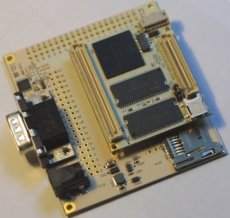
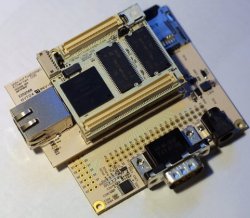
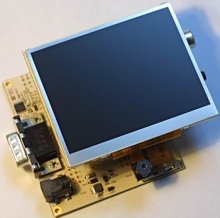

Various Cog daughterboards
(Click any image to enlarge)
Additionally, system designers are free to develop their own daughterboards, thanks to widely available connectors and “available open documention,” the company said. Virtual Cogs maintains both a Wiki and a discussion forum for its products. The “Bergstak” connectors are made by FCI, and available from Digikey, according to the company.
Linux-based software stack
On the software side, the VCMX212 ships with the uMon bootloader and a Linux 2.6.16 kernel pre-installed in NOR flash. The uMon bootloader has a filesystem of its own, enabling development without any OS. And, the i.MX21 has a built-in bootloader of its own, making the VCMX212 module “unbrickable,” according to the company.
Also included with the VC21 are “many sample code applications and cross toolchains,” Virtual Cogs said. Spokesperson Tarun Tuli said, “The VC21 is our first line of products. They have been shipping for approximately one month, and in development for around a year.”
Availability
The VCMX212 is available now, priced at $150 in single quantities. Daughterbaords range in price from $50 to $200. Further details can be found on the company's website, here. Additionally, several Linux-based projects are listed on a Virtual Cogs Wiki, here.
This article was originally published on LinuxDevices.com and has been donated to the open source community by QuinStreet Inc. Please visit LinuxToday.com for up-to-date news and articles about Linux and open source.